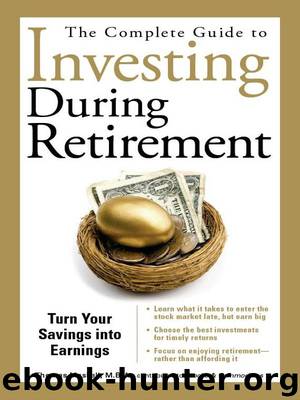The Complete Guide to Investing During Retirement by Thomas Maskell

Author:Thomas Maskell
Language: eng
Format: epub
Tags: ebook, book
Publisher: Adams Media, an F+W Media
Published: 2009-07-15T00:00:00+00:00
CHAPTER 8
Taking the Measure of the Market
There is a difference between the value of a stock and its price. The value depends on the value of the company it represents. Investors can calculate the company’s value using a series of complicated financial formulas adjusted for such intangibles as potential, business attractiveness, and risk. This is the traditional approach used to value a company. The stock value is simply the company value divided by the number of shares of stock issued.
Stock prices are quite different. The price of stock is what people will pay for it. It may or may not be related to the underlying value of the company. Price goes beyond performance; it reflects human behaviors such as greed, bias, fear, and even larceny that are inherent in the market.
Market Value Versus Market Price
Wall Street doesn’t always value companies the same as Main Street. Wall Street is a community of investors who buy stocks on the various stock exchanges. Main Street is a community of entrepreneurs who buy businesses in your local community. Wall Street will often value one dollar of profit more than another; Main Street makes no such distinction. There are many reasons for this difference, the most significant being, as you discovered in Chapter 1, the stock market can be divided into three games (investing, trading, and speculating) with three different players (investors, traders, and speculators). That mix of players creates a wide range of attitudes. Before we explore how these attitudes affect stock pricing, let’s look at how the market calculates value.
Understanding Capitalization Rate
On Main Street, the value of Company A is the present value of its future earnings. Assuming there is no growth in those earnings, the calculation of present value is simply the current annual earnings divided by the capitalization rate. The capitalization rate is just another way of saying rate of return. The capitalization rate can be anything from the inflation rate to whatever the buyer wishes to earn on her investment (her expected ROR). 1 Let’s set it at 10 percent or 0.10. Thus, the overall value of a company with $100,000 in earnings is one million dollars ($100,000 ÷ 0.10). Each share of stock has a proportionate share of that total value. With 1 million shares outstanding, the value of the stock is $1 per share. However, on Main Street, the buyer is buying the entire company (all the shares), so this per-share value will have less meaning to them than Wall Street buyers who are buying just some of the shares.
In the previous calculation, the earnings were known, the growth rate was assumed, the capitalization rate was arbitrarily set at 0.10, and we solved for value. Let’s turn the equation around. Let’s assume we already know the value of the company—the price of its stock. Since we know earnings and have assumed growth to be zero, we can solve for capitalization rate. With a stock price of $2, the capitalization rate will equal 0.05 or 5 percent ($100,000 ÷ [$2 × 1,000,000 shares]).
Download
This site does not store any files on its server. We only index and link to content provided by other sites. Please contact the content providers to delete copyright contents if any and email us, we'll remove relevant links or contents immediately.
Rich Dad Poor Dad by Robert T. Kiyosaki(6194)
Pioneering Portfolio Management by David F. Swensen(6090)
How To Win Friends and Influence People by Dale Carnegie(4341)
The Money Culture by Michael Lewis(3857)
The Dhandho Investor by Mohnish Pabrai(3573)
The Wisdom of Finance by Mihir Desai(3538)
Liar's Poker by Michael Lewis(3231)
The Intelligent Investor by Benjamin Graham Jason Zweig(2939)
The ONE Thing by Gary Keller(2924)
Mastering Bitcoin: Programming the Open Blockchain by Andreas M. Antonopoulos(2900)
Fooled by Randomness: The Hidden Role of Chance in Life and in the Markets by Nassim Nicholas Taleb(2871)
Rich Dad Poor Dad: What The Rich Teach Their Kids About Money - That The Poor And Middle Class Do Not! by Robert T. Kiyosaki(2840)
Investing For Dummies by Eric Tyson(2803)
How to Win Friends and Influence People by Dale Carnegie(2800)
How to Day Trade for a Living: Tools, Tactics, Money Management, Discipline and Trading Psychology by Andrew Aziz(2791)
Market Wizards by Jack D. Schwager(2548)
Zero Hour by Harry S. Dent Jr. & Andrew Pancholi(2538)
How to Pay Zero Taxes, 2018 by Jeff A. Schnepper(2505)
Rich Dad's Guide to Investing by Robert T. Kiyosaki(2416)
